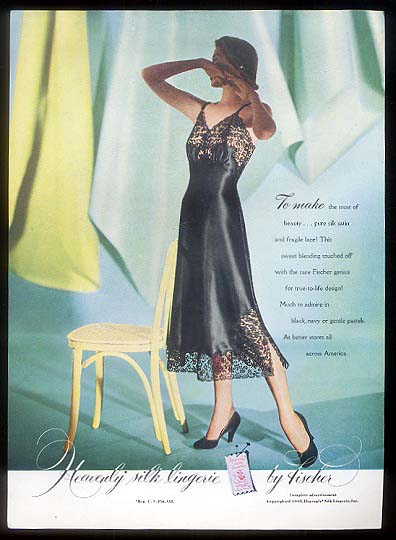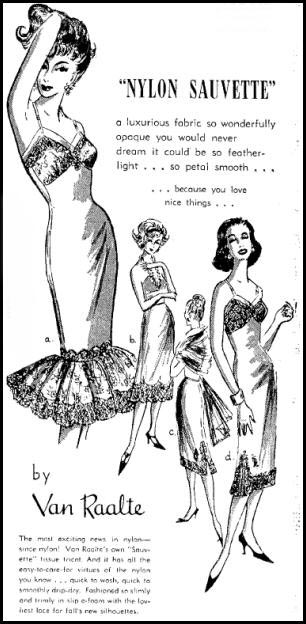An Elegant Slip Of A Girl
By MICHELLE METENS

When it comes to vintage lingerie, perhaps the most accessible garment for today’s modern woman is the full slip. Vintage slips are widely available in the online and thrift store marketplace and we receive weekly requests from women of all ages who can’t seem to find the perfect slip to suit their wardrobe needs.
The history of the slip is relatively young from the perspective that it only came about in its current form during the 20th century, though certainly layered undergarments in various forms of the chemise have been around for centuries, the slip as we know it was created for the modern woman.
To understand how the slip came about requires looking at the changes in the way women wore their foundations. As full corsets gave way to less rigid options, the soft garments that accompanied the foundations also changed.
The “combination” was first created around 1880 by combining the chemise to the drawers, then later combining the chemise with the petticoat.
 A vintage Victorian combination
A vintage Victorian combination
The combination continued to enjoy a fashionable reputation all the way through the Edwardian period. After WWI, the mood and the mores changed, hemlines went up and undies got pared down. Full corsets were out, at least for the younger set, and were replaced by much less restrictive suspender belts.

The combination adapts to the time and gives way to the “cami-knicker” version which was suited to the day. Young women of the 1920s wore their suspender belts on top of their undergarments similar to the way corsets were worn on top of the combination. Unlike the pantaloon portion of the combination, which which was split open at the center, cami-knickers were cut loose through the leg and hip to allow easy accessibility. England, 1928.
By the late 1920s French brands like Neyret and US makers like Van Raalte were forging the way forward with elegant and sophisticated designs that followed current Parisian and New York fashion. Silk knits and satins were particularly popular toward the end of the 1920s and with the introduction of the bias cut by Vionnet, soft undergarments were taking on a silhouette that followed ready to wear and couture trends. Women were also able to buy home sewing patterns featuring these same design elements.

Neyret bias cut satin slip, France, 1928.

A very sophisticated silk knit and lace “singlette” from Van Raalte, 1929. The singlette was their trade name for what was commonly known as the cami-knicker.

A late 20s or very early 1930s home sewing bias slip pattern from Simplicity. You can tell this is an early version as the bodice doesn’t have a separate adjustable strap and there isn’t much contouring over the bust.
The newly fashioned combination slip becomes one of the five must have lingerie articles for any well dressed woman, and the bias cut became the popular choice, remaining de vigueur for twenty years as a staple lingerie silhouette. Manufacturers took note and the bias cut slip, along with the stretch girdle, brassiere, panties and hosiery are the mainstays of the industry from 1930 to 1948. It was only at that time, with the perfection of the ability to mill knitted nylon tricot that the industry shifted away from woven tailored slips and towards racier garter belts and merry widow type foundations.

The silk slip remained a symbol of exquisite good taste throughout the depression, WWII and early post war years. Fischer and a few other brands continued to make silk options after 1948 but they were few and far between.
With the introduction of nylon tricot, brands like Vanity Fair and Van Raalte dominated the slip market from 1948 to 1964, developing special nylon fiber variations to create unbelievably soft knits. Van Raalte even went so far as to give each of their fabrics a special signature name.

Van Raalte Nylon Suavette, a trademarked name for one of their proprietary knits, circa 1955.
Who could forget one of the most iconic slips of all time? Head over to Etsy, find yourself a vintage slip and channel a little bit of Maggie to get in the mood for Valentine’s Day.

Elizabeth Taylor, Cat On a Hot Tin Roof, 1958.


I would love to say that my lingerie is “vintage” but unfortunately it is just old.
How well I remember the excitement of being given my first full slip. Vanity Fair and Van Raalte were my mother’s favorites and she gave me two lovely full slips on my 13th birthday……along with two long leg panty-girdles (to help form my buttocks) As I did ballet 3 times a week and rode horses twice a week, my buttocks were just fine, thank you This right of passage was a very southern tradition, perhaps like becoming old enough to give up braids and bows and put you long “hair up.”
My mother’s nighties were magnificent and her name was embroidered in the lace insert between her breasts.
She was laid to rest in her wedding trousseau ensemble which, to me, marked the true sign of a lady well-bred and well-dressed.
I have my own tucked away in special wrappings–so that it will be ready when my time comes.
Wonderful article:).